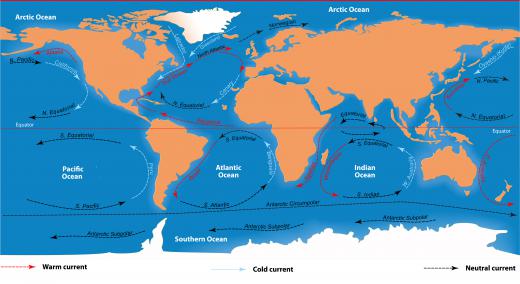What Is the Global Conveyor Belt?
The global conveyor belt is the name given to the major circulation system in the world’s oceans. Ocean water circulates on a global scale, forming flows that are known as thermohaline currents, as they are driven by temperature and salinity. The flows form large-scale loops consisting of warm surface currents and cold, deep currents. These link up where warm water cools and sinks, and where deep, cold water warms and rises. It has been estimated that the global conveyor belt takes about 1,000 years to complete a single cycle.
As seawater freezes in the Arctic region of the North Atlantic, the salt is left in the remaining water, increasing its salinity and density, and causing it to sink. Warmer water from further south flows in to take its place, while the cold, salty water flows south at a deeper level, eventually approaching the Antarctic coast. Here the flow splits into two strands, one looping round the Indian Ocean and the other forming a larger loop around the Pacific Ocean. As the water flows north into these oceans and toward the equator, it begins to warm, becoming less dense and rising to the surface north of the equator. When it encounters landmasses in the northern parts of these oceans, the water veers south again, then flows west back into the Atlantic, turning north to complete the loop.

The global conveyor belt has a major impact on climate. For example, warm water flowing into the north Atlantic toward the Arctic region has a moderating effect on winter temperatures in northwestern Europe, resulting in a much milder climate than other areas at similar latitudes. Without the global conveyor belt, the climate of the United Kingdom would resemble that of Alaska.

It has been suggested that the global conveyor belt has slowed down, been curtailed or stopped altogether at times in the past. This may have been due to melting ice sheets and glaciers in the Arctic region — for example, the Greenland ice sheet. The influx of fresh water would have reduced the salinity of the ocean water, preventing it from sinking and causing it to freeze at a higher temperature. With no sinking of water in the Arctic, the northward flow of warm water would cease; this would result in an abrupt change to a much colder climate in northern Europe. Some evidence suggests that cold spells in northern Europe in the past few tens of thousands of years have coincided with the large scale melting of Arctic ice sheets and glaciers.

There is concern that climate change may cause the global conveyor belt to stop again, drastically cooling the climate of northern Europe. Evidence suggests that temperatures are rising over the Arctic, resulting in melting of parts of the Greenland ice sheet. Some scientists fear that large quantities of fresh water from melting ice might reduce seawater salinity sufficiently to prevent it from sinking, effectively switching off the conveyor belt.
AS FEATURED ON:
AS FEATURED ON:













Discuss this Article
Post your comments